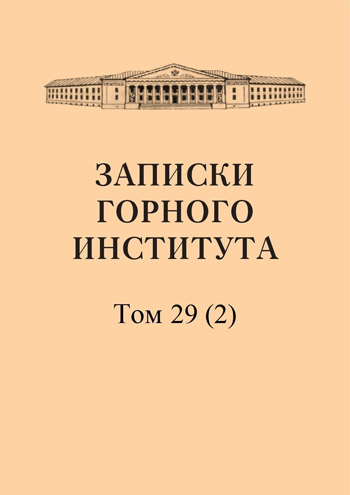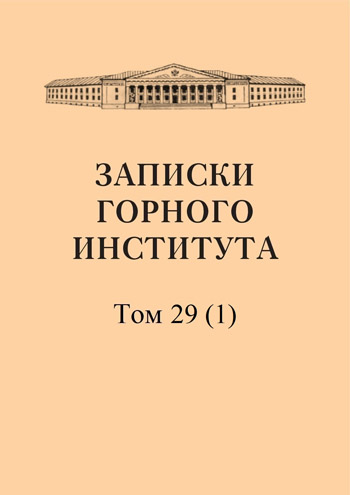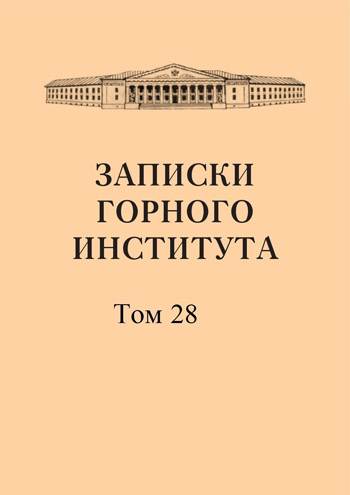-
Date submitted1952-08-01
-
Date accepted1952-10-09
-
Date published1953-07-31
Features of the formation of muscovite crystals in pegmatite veins
- Authors:
- V. D. Nikitin
As is known, there are many works on the issues of pegmatite genesis, including the processes of formation of large muscovite crystals in them. Despite this, various researchers until very recently have very contradictory opinions on a number of the most important patterns of mica formation. Therefore, the ideas about the patterns of spatial distribution of muscovite in pegmatite rocks, about the nature of the distribution of lication to depth, etc. are also contradictory. The absence of a definite solution to these main practical issues in a number of cases complicates the correct choice of methods for the prospective assessment of veins, exploration and exploitation of muscovite deposits. Let us recall that at present there are the following ideas about the genesis of large muscovite crystals.
-
Date submitted1952-08-16
-
Date accepted1952-10-08
-
Date published1953-07-31
On the issue of types of coal basins
- Authors:
- Yu. A. Zhemchuzhnikov
The issues of genetic classification and typification of coal basins are of great fundamental and practical importance. The value of such a classification will depend on the significance of the principles underlying it, on its applicability in practice and on the possibility of making a more or less complete forecast based on it. Since the appearance of G. A. Ivanov's classification of coal basins, it can be considered established that the geotectonic principle is the first and most essential for genetic subdivisions into large groups. Fifteen years after the appearance of this classification, the study of geotectonic structures now allows us to make a more detailed subdivision based on the same geotectonic principle. However, this does not exclude the possibility and necessity of having other classifications of coal basins for different purposes, based on completely different criteria. For example, basins have long been divided into parallic and limnic based on the ratio of coal-bearing sediments to the proximity of the sea. This is, so to speak, a paleogeographic division. From the point of view of exploration and study, it is important to subdivide coal basins into open, semi-closed and completely closed based on the development and preservation of the rocks covering the coal-bearing strata. For the needs of geophysical work, they can be classified by the nature of tectonic forms, i.e. by the type of dislocations, as P. I. Stepanov does. Basins can be divided into brown coal and hard coal by the quality of coal, and by age into carboniferous, Permian, Jurassic, Tertiary, etc.
-
Date submitted1952-08-17
-
Date accepted1952-10-21
-
Date published1953-07-31
Hydrogeological tapemeasure
- Authors:
- B. N. Ostoumov
A hydrogeological tape measure in combination with special tips or devices is designed to measure the water temperature level and well depth. Maximum measurement depth is 100.0 m; the diameter of the rope is 0.8 mm; the minimum weight of the tip required for normal tension of the rope is 0.4 kg.
-
Date submitted1952-08-15
-
Date accepted1952-10-10
-
Date published1953-07-31
On concretions in the coal-bearing strata of the Tkvarcheli deposit
- Authors:
- I. G. Kuprov
Concretion formations in coal-bearing strata have attracted the attention of lithologists in recent years as a phenomenon that facilitates facies analysis and reproduction of the formation environment of coal-bearing sediments. In the practice of studying coal basins, examples of the use of concretions as features for stratigraphic subdivision of coal-bearing strata and synonymy of coal seams are already known. In this regard, the concretions of the coal-bearing strata of the Tkvarcheli deposit are also of interest, a brief description of which is given in this note based on the results of the author's study of samples collected in 1949.
-
Date submitted1952-08-03
-
Date accepted1952-10-18
-
Date published1953-07-31
About the inflow into the pit, limited by a partition with a sheet pile
- Authors:
- V. I. Davidivich
In our work "Water inflow into a pit limited by a cofferdam" [3], we considered a case where the retaining horizon is supported by a watertight cofferdam, the base of which is flat and horizontal. Under these conditions, when inflowing into a pit limited by a cofferdam, the slopes of which are inclined to the horizon at an angle, the most significant quantities were determined when drawing up a production project and organizing work on the construction of a pit filtration inflow and the point of exit of the depression curve onto the slope of the pit.
-
Date submitted1952-08-25
-
Date accepted1952-10-25
-
Date published1953-07-31
Artificial soils in sports construction
- Authors:
- V. N. Novozhilov
The number of sports facilities in our country is constantly growing, dozens and hundreds of large and small stadiums, sports bases, water and rowing stations are put into operation every year. In the last period alone, the construction of the largest stadium in Europe - the S. M. Kirov Stadium in Leningrad, a large stadium in Baku and a velodrome in Moscow - was completed. The construction of sports facilities in the full sense of the word began only after the Great October Socialist Revolution. This type of cultural construction received its greatest scope during the years of Stalin's five-year plans. The construction of sports facilities as a new type of construction has set designers and builders a number of new tasks due to the requirements of sports technology. There was a need to develop principles of sports design, create technically advanced standard projects, introduce uniform standards for construction work and resolve a number of other issues.
-
Date submitted1952-08-22
-
Date accepted1952-10-07
-
Date published1953-07-31
Changes in the moisture content of clays when compacted by heavy loads
- Authors:
- V. D. Lomtadzhe
In the diagenetic processes of clay deposits, one of the most important is the process of dehydration of various silicates and aluminosilicates, which make up the bulk of their mineral part. Dehydration usually begins from the moment of sedimentation and causes a change not only in their physical state, but also in the composition of the moisture they accumulate. In parallel with the dehydration processes, complex physicochemical changes in the constituent mineral formations and sediment cementation occur in clay deposits. The ability of clays to dehydrate is determined by their relationship to water and aqueous solutions. According to modern concepts, this relationship should be considered as an active physicochemical interaction between the surface solution or solvate shell of clay particles and the external environment containing other dissolved substances. It is believed that the true surface solubility of clay particles in water determines the colloidal nature of clays.
-
Date submitted1952-08-08
-
Date accepted1952-10-09
-
Date published1953-07-31
A new method for determining the productivity of interacting wells under alluvial ground flow conditions
- Authors:
- S. P. Albul
The issue of interaction of hydrogeological wells for groundwater was studied by Soviet scientists P. P. Kusakin [3], M. E. Al'tyuvskiy [1], P. P. Argunov [2] and others. They proposed a number of formulas, which are mainly used by hydrogeologists at present. However, these formulas, as is known, require quite a lot of time for calculations and in some cases do not give the desired results. This article briefly describes a new method for calculating the productivity of interacting wells drilled in an alluvial ground flow. Based on the obtained materials on wells located normally to the alluvial flow, a new empirical formula for calculating interacting wells is proposed. To derive the recommended formula, we will first provide a brief hydrogeological description of the water intake site.
-
Date submitted1952-08-02
-
Date accepted1952-10-21
-
Date published1953-07-31
Luminescent method of prospecting and testing lead ore deposits
- Authors:
- I. S. Zhigelman
Quantitative determination of elements in rocks and ores is widely carried out on the basis of chemical and physicochemical methods of analysis. Physicochemical methods in quantitative analysis are mainly represented by spectral and polarographic methods. The luminescent method is utilized for these purposes mainly as a special method of quantitative mineralogical analysis [1]. Quantitative mineralogical analysis with the use of the luminescent method is based on the property of luminescence of some minerals when irradiated with cathode, ultraviolet and X-rays. Thus, based on the use of cathode luminescence of scheelite, its quantitative determination in scheelite ores and concentrates is carried out [2].
-
Date submitted1952-08-16
-
Date accepted1952-10-19
-
Date published1953-07-31
Application of full spectral analysis in geological expeditionary conditions
- Authors:
- M. M. Kler
- V. V. Khokholov
In the directives of the XIX Congress of the Communist Party of the Soviet Union on the fifth five-year plan for the development of the USSR for 1951-1955 in the field of industry, it is indicated, in particular: "Significantly expand the production of non-ferrous metals. Increase production over the five-year period, approximately in the following amounts: refined copper by 90 percent, lead by 2.7 times, aluminum by at least 2.6 times, zinc by 2.5 times, nickel by 53 percent and tin by 80 percent" [1]. This means an increase in geological exploration work, higher requirements for the search and exploration work carried out in terms of efficiency and comprehensive study of the objects under study. For a comprehensive study of ores, rocks and minerals, for a complete characterization of the constituent elements, spectral analysis at all stages of geological exploration work is especially important.
-
Date submitted1952-08-11
-
Date accepted1952-10-01
-
Date published1953-07-31
Study of eluvial-deluvial deposits for the purpose of searching for polymetallic deposits
- Authors:
- M. N. Chueva
- I. S. Zhigelman
Prospecting for polymetallic deposits in the conditions of Kazakhstan is very difficult in areas of smooth relief and widespread development of eluvial-deluvial deposits. Here, prospectors primarily deal with loose deposits, under the cover of which bedrock is hidden. Additional complications in searching for polymetallic deposits from the surface arise due to the fact that these deposits usually have a deeply worked oxidation zone, as a result of which primary sulfide minerals are mostly transformed into super-sulfide ones. Oxidized sulfide ores, having increased porosity, are very easily subjected to further mechanical destruction, turning into loose finely dispersed formations.
-
Date submitted1952-08-07
-
Date accepted1952-10-07
-
Date published1953-07-31
New method of sampling with a "volumetric" trench
- Authors:
- N. V. Ivanov
Sampling is an important operation in the process of exploration and study of mineral deposits. Sampling data are used to study the material composition of ores, calculate reserves of a particular component, evaluate a deposit, develop a process flow diagram, determine losses, dilution coefficient, etc. To solve the tasks set, sampling is usually carried out systematically in the process of exploration and development of a deposit. Thus, sampling of mineral deposits is accompanied by significant expenditure of funds. The method of taking samples with a "Volumetric" furrow was developed and experimented by the author on two rare metal and one copper-pyrite deposits.
-
Date submitted1952-08-02
-
Date accepted1952-10-03
-
Date published1953-07-31
Experimental studies of some technical properties of optical Iceland spar
- Authors:
- A. V. Skropyshev
Iceland spar crystals have cleavage, low hardness, brittleness and high surface tension, therefore they are extremely sensitive to various types of physical impacts (impact, pressure, sudden temperature changes, etc.). Consequently, incorrectly applied exploration and mining techniques for this mineral can lead to the damage of a significant amount of optical material. In both domestic and foreign literature, these issues are not covered at all. There are only indications of the need for careful handling of Iceland spar crystals to avoid their damage, as well as wishes to develop deposits using open-pit rather than underground methods.
-
Date submitted1952-08-19
-
Date accepted1952-10-05
-
Date published1953-07-31
Climatic zonality of artesian waters (using the USSR as an example)
- Authors:
- N. I. Tolstikhin
The zonality of groundwater and its dependence on climatic factors are covered in the works of many soil scientists and hydrogeologists - V. V. Dokuchaev, P. V. Ototsky, V. S. Ilyin, B. L. Lichkov, O. K. Lange [9]; G. A. Maksimovich [13], I. V. Garmonov [4], G. N. Kamensky [7] and others. The issue of zonality of artesian waters is considered by most authors [5, 6, 11, 14, 18] in connection with the processes of dynamics and water exchange, and the role of climatic factors is usually passed over in silence. Only in the work of A. M. Ovchinnikov [16] is it clearly stated about the deep connection of the hydrothermal regime of the earth's crust with the distribution of temperatures on its surface and the importance of this factor for the life of groundwater, in particular, for their composition. However, even in this work the role of climatic factors as factors of zonality artesian waters, artesian waters are not considered are confined to artesian basins, representing historically developing hydrogeological structures. Among artesian basins, one can distinguish open-type artesian basins confined to platforms, "artesian seas" and closed-type artesian basins located inside hydrogeological folded areas (for example, Ferghana), - "artesian lakes".


